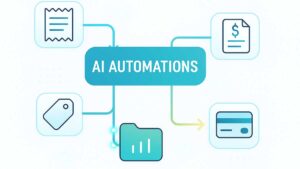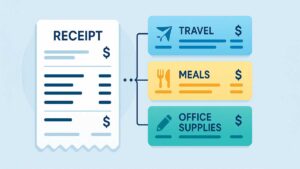Behind the Glamour: Why Creators Need Smart Expense Tracking
Being a content creator or influencer is about more than viral posts and brand deals. Behind the scenes, your success depends on how well you manage money. Tracking expenses and income may not be exciting, but it is essential for maximizing profit, reducing stress at tax time, and building a sustainable business.
This guide explains how to set up a simple system for tracking expenses, which write-offs influencers should never miss, and how tools like SparkReceipt can make the process easier.
1. Keep Business and Personal Expenses Separate
One of the most important steps for creators is to separate business spending from personal spending. Mixing the two leads to confusion and missed deductions.
- Open a business checking account or credit card.
- Use it only for expenses related to your content creation.
- If you have multiple projects or side hustles, consider using sub-accounts to keep them organized.
With SparkReceipt, you can create multiple workspaces to manage personal and professional expenses side by side. This makes it much easier to see what’s deductible when tax season arrives.
2. Track Every Receipt Digitally
Every receipt matters. Whether it’s new camera gear, software subscriptions, or even coffee from a meeting with a potential sponsor, each expense could be deductible.
Paper receipts fade and get lost. Digital receipts are easier to store, search, and share with your accountant. A receipt scanner app like SparkReceipt lets you:
- Snap a photo of paper receipts immediately.
- Automatically forward email receipts for subscriptions or online purchases.
- Store everything securely in the cloud for quick access.
Come tax time, you’ll thank yourself for having an organized digital archive instead of a shoebox full of crumpled paper.
3. Know Your Deductible Categories
This is where many creators leave money on the table. Tax-deductible expenses lower your taxable income. The key is knowing which categories apply to influencers and tracking them consistently.
Equipment and Gear
- Cameras, lenses, lighting, microphones, tripods, drones
- Computers, tablets, and phones used for creating or editing
Subscriptions and Software
- Editing software like Adobe Creative Cloud or Final Cut Pro
- Cloud storage (Dropbox, Google Drive, iCloud)
- Scheduling and social media tools (Later, Buffer, Hootsuite)
- Music licensing for YouTube or Instagram
Travel and Accommodation
- Flights, trains, or mileage for collaborations and events
- Hotels, Airbnbs, or conference lodging
- Ride-sharing costs (Uber, Lyft, taxis)
- Business meals with collaborators or clients (partial deduction)
Advertising and Marketing
- Social media ads or boosts
- Giveaways and promotional merchandise
- Branding materials like logos, business cards, or website design
- Hosting fees for websites, landing pages, or shops
Home Office Expenses
- A portion of your rent or mortgage if you use a dedicated workspace at home
- Utilities like internet, electricity, and heat
- Furniture or equipment used for work (desks, chairs, shelving)
Other Influencer-Specific Write-Offs
- Props, clothing, and costumes used in content
- Course fees, workshops, or coaching related to your niche
- Bank or payment processing fees (PayPal, Stripe)
- Business insurance for gear and liability
- Professional services like accountants, consultants, or legal help
Tip: Always keep proof of purchase. Even items that seem small – like props for a TikTok video – can add up to meaningful deductions over a year.
4. Set Regular Check-Ins
Don’t wait until tax season to organize your finances. By making expense tracking part of your routine, you avoid last-minute chaos and missed deductions.
- Snap a receipt the moment you get it.
- Set weekly or monthly check-ins to review transactions.
- Use SparkReceipt’s automatic categorization so everything is logged correctly.
Frequent check-ins also give you a real-time view of your cash flow, making it easier to spot unnecessary spending.
5. Track Your Income, Not Just Expenses
Creators often focus on deductions but forget that income tracking is equally important. Without accurate records, it’s difficult to prove earnings or understand cash flow.
Common Income Sources for Creators
- Sponsored posts and brand collaborations
- Affiliate marketing commissions
- Platform monetization (YouTube ads, TikTok Creator Fund, Twitch)
- Digital product sales (e-books, presets, courses)
- Memberships and subscriptions (Patreon, Substack)
- Gifted items provided in exchange for promotion (which may be taxable)
SparkReceipt lets you scan or upload invoices and contracts directly, so you always have documentation ready for tax reporting or audits.
6. Bonus: Prepare for Tax Season in Advance
Tax season becomes stressful when you wait until the last minute. By keeping organized digital records year-round, you make filing straightforward.
- Store receipts, invoices, and contracts in one place.
- Categorize expenses as you go.
- Share digital reports with your accountant instead of dropping off a folder of paper.
The result? No panic, fewer missed deductions, and less time wasted.
7. Use the Right Tools
Manual tracking in spreadsheets quickly becomes overwhelming. Apps designed for freelancers and creators can automate much of the process.
SparkReceipt helps you:
- Scan receipts in any language and currency
- Automatically categorize expenses into tax-friendly categories
- Track income and expenses in one place
- Generate Excel and PDF reports for your accountant
For creators juggling multiple revenue streams, these features save hours every month and reduce the risk of costly mistakes.
Conclusion
Expense tracking might not be glamorous, but for content creators and influencers, it’s the foundation of financial success. By separating accounts, digitizing receipts, knowing deductible categories, and tracking income consistently, you’ll save money and avoid stress.
With SparkReceipt, you can automate much of this work, making financial management as smooth as your next viral post. Start tracking smarter today – and make every deductible expense count.




